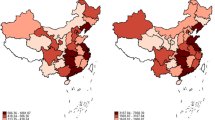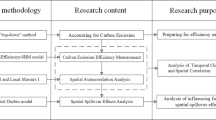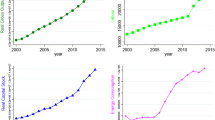Abstract
Transportation sector contributes a significant proportion to the overall carbon emission. This paper aims at measuring the impact factors of the transportation sector’s carbon emission in China’s Yangtze River Delta Area (YRDA) so that mitigation strategies on promoting low-carbon transportation can be raised. The partial least squares method and an extended STIRPAT (stochastic impacts by regression on population, affluence, and technology) model were employed for quantifying the contributions of different impact factors that affect transportation carbon emission within the YRDA region for the period of 1995–2014. Results show that population size, GDP, civilian vehicle inventory, energy intensity, passenger transportation, freight turnover, and transport sector output are key factors inducing transportation carbon emission, while energy structure and transportation sector employees mitigate the overall transportation carbon emission. Such results provide valuable policy implications for preparing appropriate mitigation strategies, such as the optimization of energy structure, the development of energy efficient technologies, the improvement of public awareness, and the implementation of intelligent transportation management.


Similar content being viewed by others
References
Chapman L (2007) Transportation and climate change: a review. J Transp Geogr 15(5):354–367
Chen F, Zhu D, Xu K (2009) Research on urban low-carbon traffic model, current situation and strategy: an empirical analysis of Shanghai. Urban Plan Forum 22(6):39–46
Dhakal S (2003) Implications of transportation policies on energy and environment in Kathmandu Valley, Nepal. Energy Policy 31(14):1493–1507
Duan H, Zhang G, Wang S, Fan Y (2018) Balancing China’s climate damage risk against emission control costs. Mitig Adapt Strateg Glob Chang 23(3):387–403
Duan H, Zhang G, Wang S, Fan Y (2019a) Robust climate change research: a review on multi-model analysis. Environ Res Lett 14:1–23
Duan H, Zhang G, Wang S, Fan Y (2019b) Integrated benefit-cost analysis between China’s optimal adaptation and targeted mitigation. Ecol Econ 160:76–86
Ehrlich PR, Holdren JP (1971) Impact of population growth. Science 171(3977):1212–1217
Grossman G M, Krueger A B (1991) Environmental impacts of a North American free trade agreement. NBER Working Papers, No. W3914
Grote M, Williams I, Preston J, Kemp S (2016) Including congestion effects in urban road traffic CO2 emissions modeling: do local government authorities have the right options? Transport Res Part D Transp Environ 43:95–106
International Energy Agency (IEA) (2009) Transport, energy and CO2: moving toward sustainability
Liao X, Shi X (2019) Public appeal, environmental regulation and green investment: evidence from China. Energy Policy 119(13):554–562
Lin B, Liu X (2010) China’s carbon dioxide emissions under the urbanization process: impact factors and abatement policies. Econ Res J 8:66–78
Liu Z, Geng Y, Dai H, Wilson J, Xie Y, Wu R, You W, Yu Z (2018) Regional impacts of launching national carbon emissions trading market: a case study of Shanghai. Appl Energy 230:232–240
Lu IJ, Lin SJ, Lewis C (2007) Decomposition and decoupling effects of carbon dioxide emission from highway transportation in Taiwan, Germany, Japan and South Korea. Energy Policy 35(6):3226–3235
Mazzarino M (2000) The economics of the greenhouse effect: evaluating the climate change impact due to the transport sector in Italy. Energy Policy 28(13):957–966
Miao Z, Baležentisc T, Shao S, Chang D (2019) Energy use, industrial soot and vehicle exhaust pollution-China’s regional air pollution recognition, performance decomposition and governance. Energy Econ 83:501–514
Schipper L, Scholl L (1997) Price, energy use and carbon from freight in ten industrialized countries: analysis of trends from 1973-1992. Transport Res D Transp Environ 2(1):57–76
Scholl L, Schipper L, Kiang N (1996) CO2 emissions from passenger transport: a comparison of international trends from 1973 to 1992. Energy Policy 24(1):17–30
Shao S, Guo L, Yu M, Yang L, Guan D (2019) Does the rebound effect matter in energy import-dependent mega-cities? Evidence from Shanghai (China). Appl Energy 241:212–228
Sun H, Geng Y, Hu L, Shi L, Xu T (2018) Measuring China’s new energy vehicle patents: a social network analysis approach. Energy 153:685–693
Sun H, Edziah BK, Sun C, Kporsu AK (2019) Institutional quality, green innovation and energy efficiency. Energy Policy 135:111002. https://doi.org/10.1016/j.enpol.2019.111002
Sun H, Mohsin M, Alharthi M, Abbas Q (2020) Measuring environmental sustainability performance of South Asia. J Clean Prod 251:119519. https://doi.org/10.1016/j.jclepro.2019.119519
The Intergovernmental Panel on Climate Change (IPCC) (2014) IPCC Fifth Assessment Report. https://www.ipcc.ch/assessment-report/ar5/
Wold H (1985) Partial least squares. In: Kotz S, Johnson NL (eds) Encyclopedia of statistical sciences, vol 6. Wiley, New York, pp 581–591
Wu C, Xiong J, Wu W, Gao W, Liu X (2015) Calculation and effect factor analysis of transport carbon emission in Gansu province based on STIRPAT model. J Glaciol Geocryol 37(3):826–834
Xia Q, Li M, Wu H, Lu Z (2016) Does the central government’s environmental policy work? Evidence from the provincial-level environment efficiency in China. Sustainability 1241(8):1–17
Yang Z, Shao S, Yang L, Liu J (2017) Differentiated effects of diversified technological sources on energy-saving technological progress: empirical evidence from China’s industrial sectors. Renew Sust Energ Rev 72:1379–1388
York RP, Rosa EA, Dietz T (2003) STIRPAT, IPAT and IMPACT: analytic tools for unpacking the driving forces of environmental impacts. Ecol Econ 46(3):351–365
Zhang TX (2012) Research on China’s urban road transport carbon emissions under urbanization process. China Populat Resourc Environ 8:3–9
Zhang X, Yang X, Yan Y (2014) Statistical estimation method for energy consumption and carbon emissions by urban transport. China Soft Sci 6:142–150
Zhang P, Shi X, Sun Y, Cui J, Shao S (2019) Have China’s provinces achieved their targets of energy intensity reduction? Reassessment based on nighttime lighting data. Energy Policy 128(5):276–283
Zhou P, Ang BW, Poh KL (2008) Measuring environmental performance under different environmental DEA technologies. Energy Econ 30(1):1–14
Zhu J, Sun H, Zhou D, Peng L, Sun C (2019) Carbon emission efficiency of thermal power in different regions of China and spatial correlations. Mitig Adapt Strateg Glob Chang. https://doi.org/10.1007/s11027-019-09901-5
Acknowledgments
The authors appreciate the valuable comments of anonymous referees. We are also grateful to the financial support provided by the National Natural Science Foundation of China (No. 71774071, 72088101, 71690241, 71810107001) and the Key Project of Jiangsu Social Science Fund (20ZLA007).
Author information
Authors and Affiliations
Corresponding authors
Additional information
Publisher’s note
Springer Nature remains neutral with regard to jurisdictional claims in published maps and institutional affiliations.
Rights and permissions
About this article
Cite this article
Sun, H., Hu, L., Geng, Y. et al. Uncovering impact factors of carbon emissions from transportation sector: evidence from China’s Yangtze River Delta Area. Mitig Adapt Strateg Glob Change 25, 1423–1437 (2020). https://doi.org/10.1007/s11027-020-09934-1
Received:
Accepted:
Published:
Issue Date:
DOI: https://doi.org/10.1007/s11027-020-09934-1




